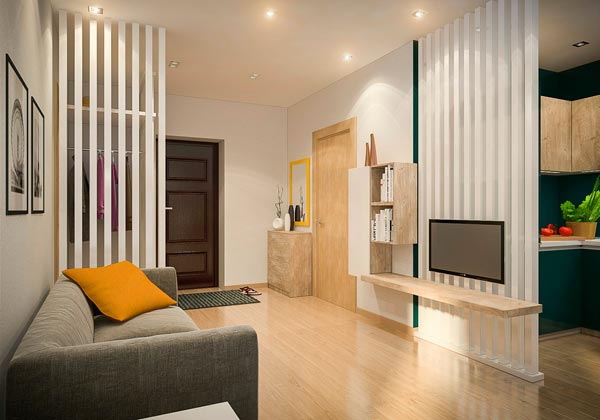We use partitions to divide into zones
One-room apartments are actively sold in the real estate market, both in new buildings and in the secondary market. The one-room apartment is an intermediate residence for young just formed families who want to live in their property and not pay a permanent rent to the owners. In addition, the availability of prices for one-bedroom apartments determines the constant demand for such property. Having bought such an apartment, the first thing that the new owners think is how to make repairs in the apartment and design it so that you can feel comfortable and comfortable in the new property.
How can I arrange a one-room apartment? It all depends on the owners, on their desires and capabilities. Yes, of course, a one-room apartment limits its owners a little, because you won’t especially turn around in it. Nevertheless, the presence of imagination, as well as a clear understanding of what you want to get in the end, should play a key role in this matter. If everything is quite obvious with a bath and a balcony, then the room and the kitchen are a vast expanse for your ideas.
Making your apartment is best done on the principle of zoning, highlighting all the elements you need, such as, for example, a sleeping place, a recreation area, a work area, and if there is a child, a children's area. But the most difficult thing is to decide how to draw the boundaries between the zones. Which partitions to use? And how do they fit into the design?
Mobile partitions
Of course, there are many ways to divide the zones in the apartment, which are suitable for a particular interior. It is possible to differentiate the territory of a room by the color principle, it is possible to make different levels of the floor and ceiling in a particular zone. But it will be most correct to use partitions, which are of two types: mobile and stationary. Mobile fences can take two positions during the day, the first - to move apart, and the second - to move. During the day, the position of the mobile partitions can be changed several times. These fences include:
- Sliding doors. With their help, you can fence off any zone in the apartment, but most often this kind of partition is used for the visual border between the room and the kitchen.
- Curtains. As mobile partitions, curtains can also act. Most owners separate the sleeping area in such a way as to give this place privacy and tranquility. Many girls like to install various canopies over their beds.
It should be said that the mobile partitions in their closed state give the one-room apartment some mystery. And each guest will want to solve the mystery by opening the door or sliding the curtain.
Stationary partitions
Another option for design in the apartment may be stationary partitions. From the name itself it becomes clear that in what position you make them, so they will stand. So you should carefully weigh all the options in order to choose the right interior. But the choice of stationary partitions is much wider than mobile. Here are the most popular fixed partitions:
- Rack. This is equipment that can be used not only for some personal items, but also as a separator between, for example, a work area and a resting place. Shelves are different in height and length, you can order an individual design.
- False wall.The whole point is in the name of the partition, on the one hand it is a wall, on the other it is a snag. Such a fence extends along the entire height of the room, that is, from floor to ceiling, and due to the side and floor fasteners, the partition is considered stationary.
How to choose the right partition
Do not forget that the repair of any apartment is a painstaking process, it is worth approaching its decision responsibly, having foreseen all possible types of partitions in your apartment in advance. Of course, you can do it yourself, deciding what will be located. You can also contact a professional design studio, whose representatives have vast experience in this field, and in the shortest possible time will select the best interior for your property.














